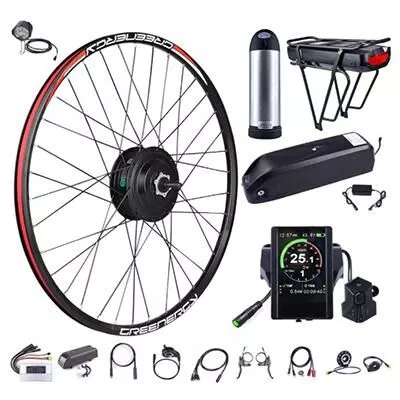E-bikes have become quite a sensation in the modern era. These days, enjoying the benefits of riding an electric bike without buying one–which is expensive–is relatively easy, thanks to e-bike conversion kits.
Even better, you are not limited to options as you can settle for any type depending on your preferences. So, if you’re looking forward to motorizing your current bike, then continue reading to find out how.
Types of conversion kits
The E-bike market is flooded with various types of conversion kits. The common primary ones include;
- Rear-Wheel kits: there isn’t much difference between this kit and the front-wheel kit except that this one is installed on the rear wheel. This kit makes riding on terrain relatively easy. It’s only downside is that it’s a bit heavy, making the rear part of the bike heavier.
- Front-Wheel Conversion kits: as previously mentioned, these kits operate much like the rear ones. Only that they’re installed on the front wheel. Once you’ve connected the kit’s components to a battery, the front wheel should be powdered. The components include; controls and speed sensors.
- Mid-Drive conversion Kits: These conversion kits are far different from the front and rear wheel kits. This kit is placed at the bike’s center between the rear and the front wheel. To power the bike, you simply connect the chain to the motor.
Things To Consider Before Buying an E-bike Conversion Kit
It isn’t easy to identify the correct kit that’ll suit your needs, especially since the market is loaded with many of these devices. This may even make it challenging to figure out how to convert your current bike to an e-bike.
There are manufacturers out there with helpful specifications lists that mainly include;
- Type of the brakes and the configurations
- The rear frame width—the back metallic triangle frame to the bike’s rear wheel is attached to.
- The type of the freewheel and the cassette—usually the cylindrical piece beneath the back gears which click when coasting.
- Width of the shocks or the front forks—primarily what the front wheel is attached to.
- The dimensions of the rim and the wheel diameter
To ensure you’re installing the kit without risking ill system-fitting, ensure your bike’s features match the manufacturer’s specifications per the above details.
Factors Worth Paying Attention to
- Drive location: typically, a front hub is the easiest to install. The rear one is a bit complex, with the mid-drive being the most complex.
- Cost: choosing the cheapest conversion kit is better if you’re considering installing one on your bike for the first time. But if you’re a niche industry expert, a high-quality kit will be an excellent investment in the long run.
- Type of battery (amp hour rating and voltage): the minimum battery (lithium-based) specs of an ideal conversion kit are: 36 or 48 volts and a wattage range between 300-600 watts. Also, remember to look for a 10ah battery rating. Overall, the battery will depend on the rider’s weight, intended bike use, budget and terrain.
How to Install an E-bike Conversion Kit
- Swap the Entire Tire and the Tire Tube
First things first, you’ll have to remove your current tire wheel, whether it’s the rear or the front —in this case, it’s the front— depending on the kit. Then install the ones the kit comes with.
More importantly, ensure the cable from the hub sticks on the Left-hand side after installing the wheel. This is necessary, or you risk powering the bike in the opposite direction as opposed to the kit.
Using a tire pump and levers, swap the new kit’s tire and the tire tube with the current ones. Finally, fasten the ax nuts to keep the wheel firmly fixed on the forks. If you’re unsure how to do that, visit this webpage for guidance.
- Attach the Handlebar to the Bracket Properly
It would be to prevent the bracket from rotating around by fixing the strap that comes with the kit to the handlebars. Included in the kit are some adaptors you can use for skinnier handlebars.
- Attach the Magnet Disc to the Sensor
Bear in mind; that the magnet disc is made in a split design. From the inside, clip this magnet disc from the left non-drive side crank.
Proceed by holding it in place using a retention ring. Then stick the sensors directly on the frame and ensure they align well with the magnets. That way, it’ll be easier for the sensor to detect the crank’s movements.
- Plugging in the Cables
Plug in the thick cable (power cable) into the one extending from the hub. Then attach the other orange cable to the cadence center properly.
To tidy up the cable lengths and prevent them from getting caught on the cranks or the spokes, use cable ties. Don’t worry about the blue cables, as they are meant for an optional brake sensor.
E-Bike Conversion Kit Pros & cons
Conversion kits are niche-driven products with a special place in the e-bike world. While some people love riding a prebuilt e-bike, some enjoy the technical challenge of converting a conventional bike into an e-bike.
However, most individuals don’t see any significant merits regarding purpose-built e-bikes durability, price and performance. Some of the advantages and disadvantages of these conversion kits include;
Pros:
- It may save you on the initial costs. Just remember to factor in the battery
- The kit offers an enjoyable e-bike conversion experience for a mechanical hobbyist.
- Purchasing an e-bike conversion kit is less expensive than a brand new e-bike.
- Most conversion kits have at least one year warranty
- You get to keep that bike that bears sentimental value to you.
Cons:
- The maximum speed may not match that of a prebuilt e-bike
- Installing a new motor on your old bike may not necessarily be the best investment decision
Which Kit is for Me and How do I Fit It?
The right kit that suits your preference largely depends on your budget, familiarity with various types of kits, etc. If you prefer simplicity when it comes to installation, either go for the rear or the front wheel conversion kits.
But if you prefer the challenge of the complex kit installation process, go for the mid-drive kits. A good option for mid-drive kits would be the BAFANG BBS02 48V 750W.
The Electric Bike 48V 1500W is a good fit for those seeking a rear-wheel Conversion Kit. If you’d prefer to buy a reliable front wheel conversion kit, E-Bike 48V 1000W 27.5″ Hub Motor is worth considering.
Conclusion
Depending on your intention of use, if you’d like your bike to climb steep terrains easily, then a mid-drive kit will do just fine. But if you’d like to pedal under your own steam and for an extended period, a small motor hub is the way to go–usually the front wheel conversion kit.

